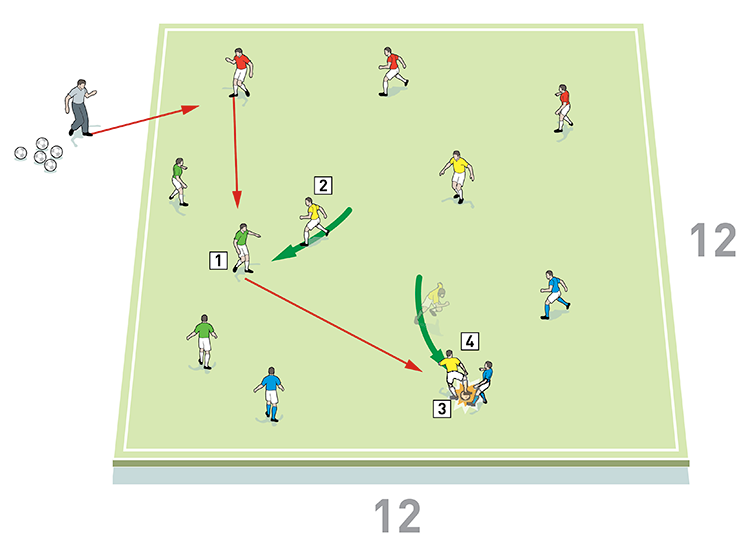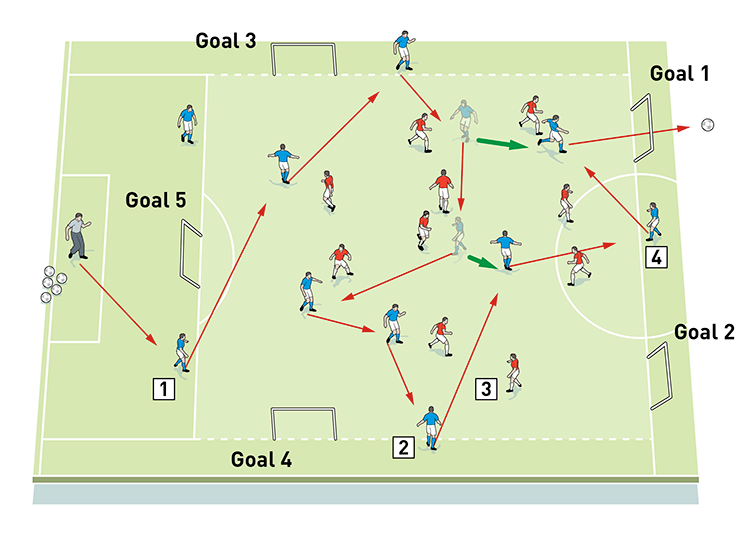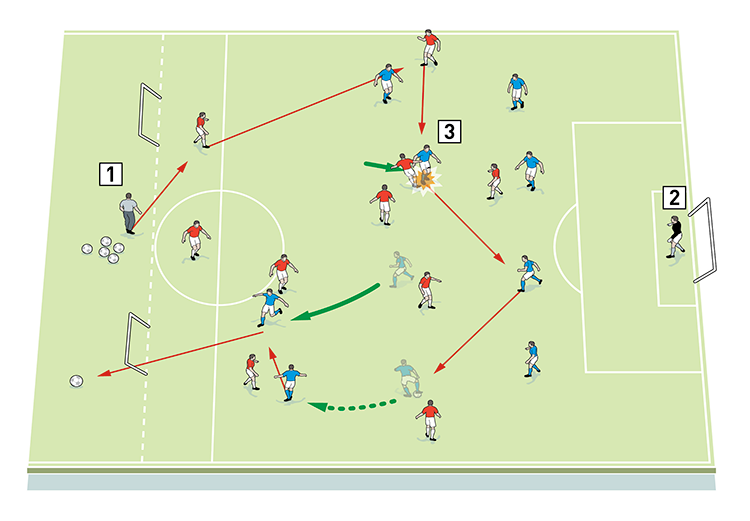You are viewing 1 of your 1 free articles
Defensive transition
This session is all about the transition to defence. What do we want our team to do when we lose the ball and how do we expect our players to react? These are key questions to be answered when we think about setting principles for this moment of the game.
| Area | Up to two thirds of a pitch |
| Equipment | Balls, bibs, cones, 5 small goals, 1 full size goal |
| No. of Players | Up to 20 players + 1 goalkeeper |
| Session Time |
Rondo 9v3: 10mins, System ball possession: 15mins, Horizontal and vertical compaction: 30mins, Game: 30mins |
This session is all about the transition to defence. What do we want our team to do when we lose the ball and how do we expect our players to react? These are key questions to be answered when we think about setting principles for this moment of the game.
We want players to take decisive action to limit the quick attacking possibilities of our opponents by immediately covering the ball and pressing the area around it.
In order to achieve this, we consider a major principle of our game to be pressing after losing the ball. Having possession is undoubtedly the best way to control a game, nevertheless limiting the possibilities of the other team to settle into their game is also a key factor.
Reacting quickly to losing the ball, pressing the player with the ball, and shortening spaces around it, might allow us not only to regain possession, but also in instances when we don’t succeed, to limit the impact of quick attacks, allowing the establishment of a higher defensive balance.
What do I get the players to do?
Rondo 9v3
We set up an area of 12x12 yards. We’re using 12 players split into four teams of three. Play starts with three of the teams working together to keep possession from the fourth team, making it a 9v3 situation. The pressing team must try to win the ball.
When one of the passing players loses possession, his team of three swaps roles with the pressing team and must react immediately to the transition by trying to win the ball back.
All players are one touch except the player who wins the ball, who is allowed unlimited touches until he passes.
We play two five-minute games.
1

2. The yellow team is on its own, pressing to win possession
3. Here a blue loses the ball. His team now become the pressers, quickly transitioning into their new role
4. The player who wins the ball has unlimited touches until he passes. The yellows now join the reds and greens in keeping possession.
System ball possession
We set up an area of 20x20 yards. We’re using 20 outfield players split into two teams of 10, who work on ball possession. Each team has five players in the central zone and five players around the outside, as shown [2a].
2a

2. The blues can use the support of their outside players
3. The reds press and try to win possession
4. The blues score a point if the ball passes through all 10 of their players
To start the practice, both teams are set-up as if they were in a 4-2-3-1 formation, with the five central players comprising two central midfielders, two wingers and an attacking midfielder. The five supporting players on the outside are made up of two central defenders, two full backs and a striker.
One team keeps possession using all of its players, scoring a point if all 10 players touch the ball. The other team tries to win the ball with the central players pressing.
When possession is won, the team that gains the ball must make at least three passes before being allowed to pass to an outside player to score a point. The team that lost the ball must quickly try to regain it and now even their outside players are allowed to enter the central area and press, as shown [2b]. They score a point if they recover the ball and manage to make five passes.
2b

2. When the blues lose possession, their outside players can enter the central area and join the press
3. With all 10 of their players now in the central area, if the blues regain the ball they must make five passes to score a point
The activity restarts with its initial set-up. We play for 15 minutes.
Horizontal and vertical compaction
We set up between the penalty area and the halfway line of our pitch, coned off to the width of the penalty area. We’re using five small goals, with two at one end (goals 1 and 2), one at the other end (goal 5) and two positioned on opposite sides of the playing area (goals 3 and 4). We’re using 20 players split into two teams of 10.
The team that starts in possession has five players inside the playing area (two central midfielders, two wingers and an attacking midfielder) and five supporting players around the outside (two central defenders, two full backs and a striker). The other team has 10 players inside the playing area and is set-up in a defensive formation.
The team that starts in possession must make 10 passes on the way to trying to score in goals 1 and 2, as shown [3a]. They use the outside players to help them when they attack, using the width and depth given to them by the supporting players in order to unbalance the defensive organization of their opponents.
3a

2. The five central blues must attack goals 1 and 2 using their team mates outside the area, which will give them width and depth
3. The reds have all 10 players inside the playing area and they press to win the ball
4. The blues must complete 10 passes before being able to shoot
If the defending team wins the ball, they must make a minimum of three passes before they can counter-attack goals 3, 4 or 5. To stop them scoring, the outside players are now able to enter the playing area to even things up for the team that lost the ball, making it 10v10, as shown [3b]. They must quickly transition into a defensive organisation, making the team’s vertical and horizontal shape more compact, and then attempt to regain the ball.
3b

2. Here the reds intercept the ball and win possession
3. After the blues lose the ball, their five outside players can enter the playing area to make it 10v10 in the central area
4. To allow the blues to transition into a defensive organisation, the reds must make at least three passes before attacking goals 3, 4 or 5
Play restarts from the coach, who plays a ball to the possession team. We play two 15-minute games.
How would you put this into a game situation?
Game 10v8 plus keeper
We set up on just over half a pitch, with a full size goal in its normal position at one end and two small goals at the other end. We’re using 18 outfield players and a goalkeeper, split into an attacking team of 10 and a defending team of eight plus the keeper.
The team of 10 starts with the ball and they attack the large goal, using smart possession to unbalance the defensive organization of their opponents and using space to create scoring opportunities.
The defending team are set up in two banks of four and if they win the ball, they try to score in the two small goals, as shown [4]. In response to losing possession, the attacking team must quickly transition into a defensive organization.
4

2. The reds attack the large goal guarded by the goalkeeper
3. If the blue defending team of eight wins the ball, they try to score in the two small goals
We play two 15-minute games.
What are the key things to look out for?
The main principle for the transition from attack to defence is setting out to immediately recover the ball upon loss of possession. In order to be able to perform this well, it’s important that the team properly masters both phases of the transition.
The first phase is to quickly press high upon the loss of possession in order to recover the ball in the shortest time possible, keeping the team high on the pitch.
The second phase is necessary if the opponents play away from pressure. If that happens, your team needs to make a collective readjustment to the new ball position, permanently pressing the ball and reorganizing the team’s balance.
What are the typical mistakes players might make and how do I avoid them?
We might expect to see players individually failing to react to the transition to defence, or not pressing with enough intensity. This would allow the ball to reach a free player away from the pressing zone. Another typical mistake is a failure to maintain pressure on the ball after it has been played out of the pressing zone.
Related Files
Editor's Picks
Intensive boxes drill with goals
Penetrating the final third
Creating and finishing
My philosophy
Pressing initiation
Compact team movement
Defensive organisation
Back three tactics
Counter-pressing as an offensive weapon
Coaches' Testimonials

Alan Pardew

Arsène Wenger

Brendan Rodgers

Carlos Carvalhal

José Mourinho

Jürgen Klopp

Pep Guardiola

Roy Hodgson

Sir Alex Ferguson

Steven Gerrard
Coaches' Testimonials

Gerald Kearney, Downtown Las Vegas Soccer Club

Paul Butler, Florida, USA

Rick Shields, Springboro, USA

Tony Green, Pierrefonds Titans, Quebec, Canada
Join the world's leading coaches and managers and discover for yourself one of the best kept secrets in coaching. No other training tool on the planet is written or read by the calibre of names you’ll find in Elite Soccer.
In a recent survey 92% of subscribers said Elite Soccer makes them more confident, 89% said it makes them a more effective coach and 91% said it makes them more inspired.
Get Monthly Inspiration
All the latest techniques and approaches
Since 2010 Elite Soccer has given subscribers exclusive insight into the training ground practices of the world’s best coaches. Published in partnership with the League Managers Association we have unparalleled access to the leading lights in the English leagues, as well as a host of international managers.
Elite Soccer exclusively features sessions written by the coaches themselves. There are no observed sessions and no sessions “in the style of”, just first-hand advice delivered direct to you from the coach.








